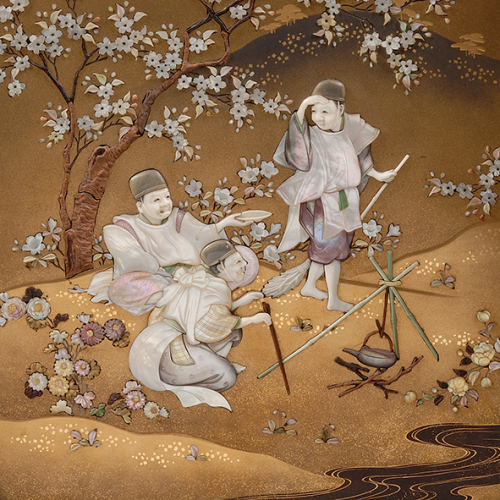

With grateful thanks to Laura Bordignon of Laura Bordignon Antiques.
The art form known as Shibayama become very popular with the feudal daimyo lords and the wealthy merchants during the rule of Tokugawa Ienari (1773-1841) the eleventh shōgun of the Tokugawa shogunate of Japan.
Shibayama (芝山象嵌細工) was the mosaic-like inlay technique used to decorate Japanese objects such as inro, vases, dishes, table screens, incense burners (koro), panels and large cabinets.
A great variety of materials were used, including mother-of-pearl, tortoiseshell, abalone, coconut shell, bone, ivory, horn, amber and coral. This highly-skilled work required the meticulous carving of very small fragments, which were then patiently inlaid into a gold lacquer, wood or ivory base.
Just as in a jigsaw puzzle these pieces ultimately formed a complete scene. The subjects chosen for these decorations were predominantly landscapes, flora, fauna, mythological figures or scenes from traditional Japanese life.
This Japanese Shibayama table screen features two gold lacquer panels minutely inlaid with a picture of a young boy accompanied by two servants on a cherry blossom viewing (hanami 花見) in carved mother-of-pearl, tortoiseshell, stained ivory, and coconut-shell. The intricate design is set against a background of togidashi and hiramakie on a kinji ground. On the lacquer reverse, there is a depiction of a nocturnal scene with cranes amongst lakeside rushes. The piece is signed reserve Masakazu 政一and Kako 花光 on the black lacquer reverse, indicating its origin in the Meiji period.
 This decorative style of Shibayama inlaid work was started by Ōnogi Senzō (1775-1836) 大野木仙蔵 who was from the town of Shibayama in the Shimosa Province in the An’ei era (1772-1781).
This decorative style of Shibayama inlaid work was started by Ōnogi Senzō (1775-1836) 大野木仙蔵 who was from the town of Shibayama in the Shimosa Province in the An’ei era (1772-1781).
He was from a farming family, and in order to further his artistic career, Senzō moved to the capital Edo, and adopted the name of his home town Shibayama to his surname (Shibayama Senzō). Shibayama Senzō I is credited with founding the Shibayama School and had many followers.
His grandson, Shibayama Senzō III (芝山仙蔵三代) succeeded him in the School. However, it was Shibayama Sōichi (芝山宗一) a disciple of of Shibayama Senzō II, who was responsible for spreading the artistic reputation of Shibayama works.
Relocating from Tokyo to the large port town of Yokohama was a decisive moment for Shibayama Sōichi and for the successive Shibayama artists, as it opened the gateway to the export market.
In 1867 at the Paris Exposition Universelle many Shibayama works were exhibited and proved extremely popular with Westerners who visited the exposition.
During the Meiji period (1868-1912) the fascination with these exotic objects started a fashion for Shibayama lacquer objects and craftsmen did predominantly cater to a Western clientele.
 Today the popularity of Shibayama works continues and is a very strong collecting field.
Today the popularity of Shibayama works continues and is a very strong collecting field.
Click here to read the full article.
Click here to view examples of Japanese Shibayama art currently available from BADA members.

